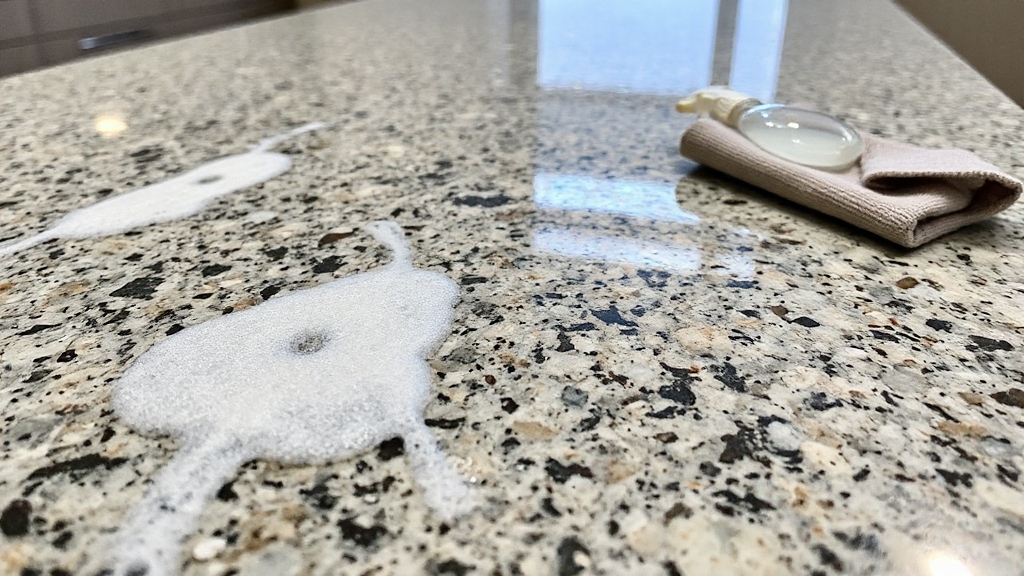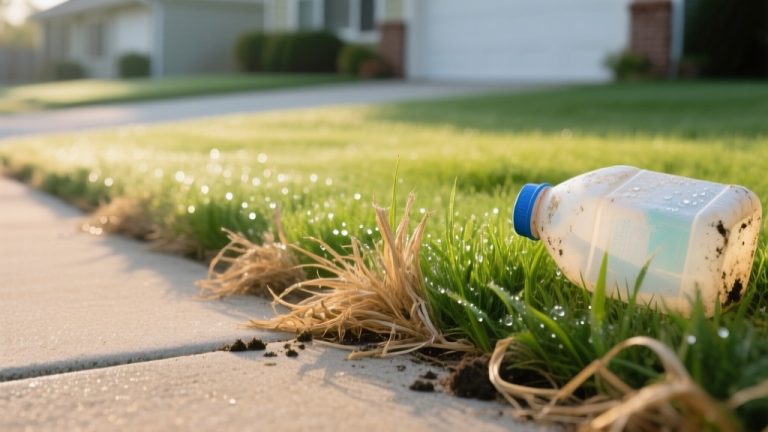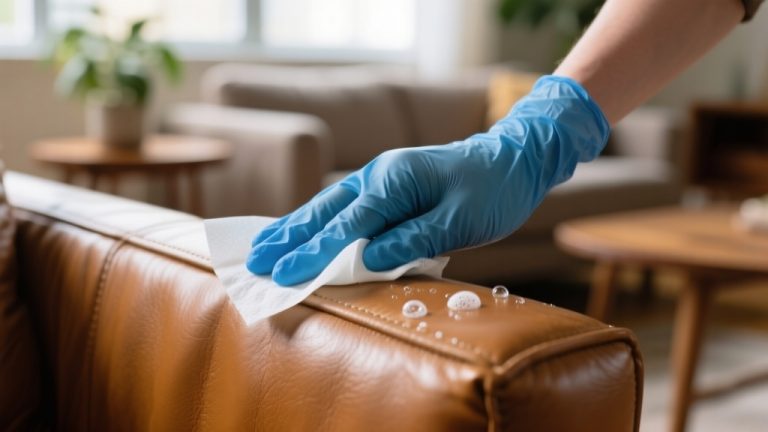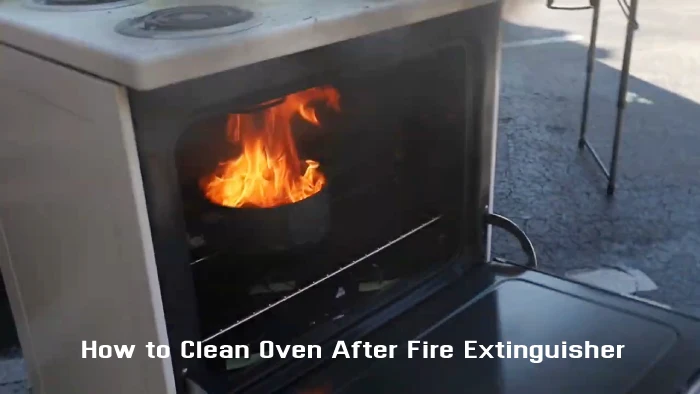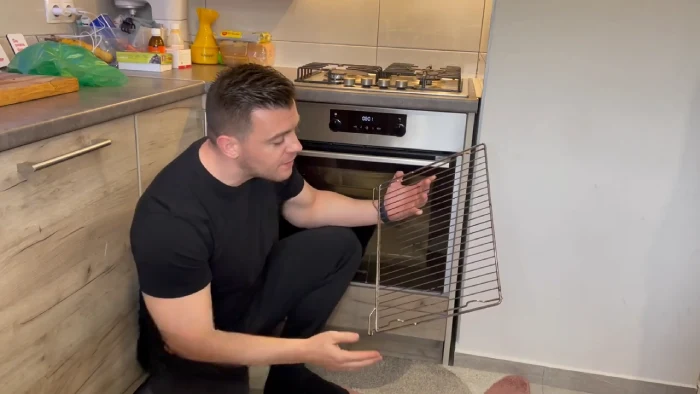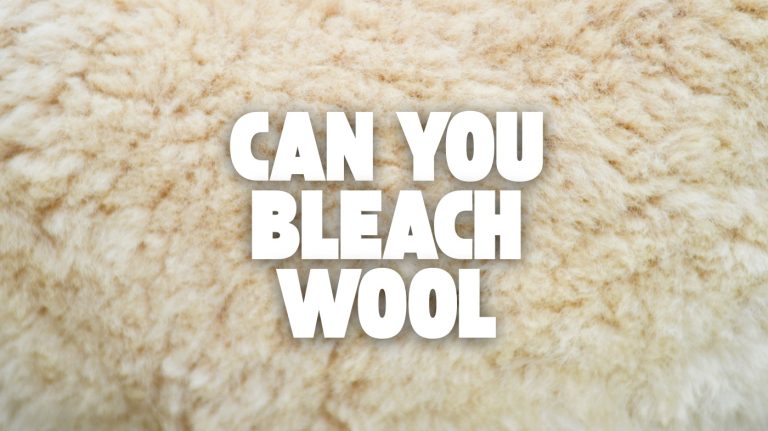How to Remove Soap Scum From Granite? Quick and Gentle Tips
To remove soap scum from granite, start by using a mild, pH-neutral cleaner mixed with distilled water and a splash of isopropyl alcohol.
Gently scrub with a soft cloth or brush to avoid scratching the surface. Avoid acidic or abrasive cleaners that can damage the stone.
Rinse thoroughly and dry immediately to prevent residue buildup. Regularly sealing your granite helps keep soap scum at bay.
Discover effective cleaning techniques and maintenance tips to keep your granite looking pristine.
Key Takeaways
- Use a mild dish soap mixed with distilled water and isopropyl alcohol, applying with a soft cloth to gently remove soap scum without damaging granite.
- For tough buildup, apply diluted washing soda with a soft-bristled brush, avoiding acidic or abrasive cleaners that harm granite’s surface.
- Rinse thoroughly with plain water after cleaning, then dry immediately with a soft cloth to prevent water spots and residue.
- Regularly seal granite surfaces to protect against soap scum absorption and maintain the stone’s natural shine and integrity.
- Perform weekly cleaning with pH-neutral, stone-safe products and dry surfaces after use to minimize soap scum accumulation.
About Soap Scum on Granite Surfaces
Although soap scum might seem harmless, it forms a stubborn, insoluble film on your granite surfaces by combining soap molecules with minerals like calcium and magnesium in water.
Soap scum creates a tough, insoluble film on granite by bonding soap with minerals like calcium and magnesium.
This chemical reaction causes soap molecules to lose solubility, precipitating out as a white or grayish layer that clings tightly to granite. You’ll notice soap scum dulls the natural shine and leaves streaks, obscuring your granite’s beauty.
Because it’s a complex mixture of soap and mineral ions, soap scum doesn’t dissolve easily in water. Removing it requires careful methods to avoid damaging the stone, as harsh treatments can harm granite.
Common Causes of Soap Scum Formation
When soap interacts with minerals like calcium and magnesium found in hard water, it creates insoluble compounds that cling to your granite surfaces as soap scum.
This buildup happens because hard water minerals react with soap molecules, forming residues that stick stubbornly. Frequent soap use in showers or basins increases this buildup, especially if you don’t dry the surfaces thoroughly afterward.
Granite’s porous nature allows it to absorb soap residues, making removal tougher. Environmental factors like bathroom temperature and humidity also influence soap scum formation by affecting drying and moisture levels. Regular maintenance can help manage soap stains effectively soap stains.
Additionally, soaps with high fatty acid content or concentrated formulas can accelerate scum development. Poor cleaning habits and inadequate ventilation further worsen the issue.
Identifying Soap Scum Stains on Granite
You’ll often spot soap scum on granite as a chalky white film or stubborn patches near sinks and showers. Below, we’ll show you how to identify these stains clearly and treat them effectively to restore your granite’s natural beauty.
Soap Scum Appearance
Since soap scum forms from the reaction between soap and minerals in water, you can identify it on granite by its dull, greasy film that often feels smooth and slightly sticky.
Soap scum stains vary in color—white, grayish, or brownish—depending on the soap and minerals involved. You’ll commonly find these stains near sinks, faucets, and other soap-exposed areas.
Unlike grease or food stains, soap scum appears more uniform and brittle, lacking vibrant colors or circular patterns. It doesn’t etch the granite but can dull its surface over time.
To address the buildup, you can gently clean the stained area using a microfiber cloth dampened with a mild soapy solution.
Cause of Soap Scum
Although soap scum may look like a simple surface stain, its formation involves a complex chemical reaction between soap molecules and the minerals in hard water.
Hard water contains calcium and magnesium ions, which react with the fatty acids in soap to form insoluble compounds called soap scum. This compound precipitates onto your granite surface, creating a white, powdery, greasy film that dulls its shine.
Frequent soap use, poor rinsing, and high evaporation rates accelerate buildup, especially near faucets and soap dispensers. The mineral concentration varies by region, influencing how stubborn the deposits get.
Because soap scum is water-insoluble and adheres strongly, it resists simple cleaning, requiring specific methods to remove it without damaging your granite’s finish.
Hard water contains minerals that leave deposits on granite surfaces, contributing to the formation of stubborn stains.
Effects on Granite
When soap molecules bind with minerals like calcium and magnesium in your water, they create a residue that settles on your granite surface.
This soap scum forms a dull, sticky film that water alone can’t remove. Over time, it can cling to granite pores, making cleaning tougher and dulling your granite’s shine. Regular cleaning with a microfiber cloth helps prevent buildup and protects your granite’s sealant.
Here’s what to watch for:
- Soap scum appears as a dull, sticky film, especially near sinks or soap-use areas.
- It doesn’t leave visible mineral deposits like water stains but still affects surface appearance.
- Prolonged buildup can weaken the granite sealer, though it’s less damaging than acidic substances.
Using Household Ingredients to Remove Soap Scum
If you want to remove soap scum from granite without risking damage, using household ingredients offers a safe and effective solution.
Start by mixing mild dish soap with distilled water and a splash of isopropyl alcohol to boost cleaning power. This neutral pH cleaner helps avoid damage to the granite sealer.
Add a few drops of essential oils like lemon or eucalyptus for a fresh scent. Spray this mixture on the surface and wipe with a microfiber cloth.
For tougher buildup, dilute washing soda in water and gently scrub with a soft-bristled brush to break down soap deposits. Avoid acidic cleaners like vinegar or harsh detergents, as they can etch or dull granite.
Applying Commercial Granite Cleaners Safely
Choose a commercial cleaner specifically formulated for granite to protect your surface from damage.
Choosing Suitable Granite Cleaners
Since granite is sensitive to acidic and abrasive substances, you need to select cleaners that are pH-neutral and specifically formulated for granite surfaces. This prevents etching and helps maintain the stone’s natural beauty.
When choosing a commercial granite cleaner, consider these key factors:
- Formulation and Compatibility: Pick a non-abrasive, pH-neutral cleaner safe for granite and surrounding materials like metal or glass. The Good Housekeeping Institute Cleaning Lab tests products to ensure their formulas are safe for natural stone.
- Concentrated vs. Ready-to-Use: Concentrated cleaners save money but require careful dilution; ready-to-use products offer convenience.
- Eco-Friendliness and Professional Endorsement: Opt for eco-friendly options if preferred, and choose products recommended by professionals for proven effectiveness.
Proper Application Techniques
Before applying any commercial granite cleaner, you should prepare the surface properly to guarantee safe and effective cleaning.
Start by removing loose debris and dust, then test the cleaner on a small, hidden spot to verify it won’t damage the stone.
Protect surrounding areas from splashes. It is also important to check if the granite has been treated with a sealer or enhancer before cleaning.
Use soft cloths or sponges for application to avoid scratching. Apply the cleaner evenly by spraying lightly or using a soft-bristled brush, depending on the product’s instructions. Control spray pressure to prevent damage and avoid soaking the granite to reduce water spots.
Make sure the entire soap scum area is covered. Allow the cleaner to sit for the recommended dwell time to break down grime effectively. Always wear gloves and verify good ventilation while working.
Post-Cleaning Rinse Procedures
Although cleaning removes most soap scum, you’ll need to rinse the granite thoroughly with plain water to eliminate any leftover residue that can cause film buildup.
Using only water prevents soap or cleaner remnants from dulling your granite’s shine. After rinsing, dry the surface immediately with a soft cloth to avoid water spots, especially if your water is hard.
For routine maintenance, using dish soap and a microfiber towel is recommended as it effectively cleans granite without causing etching or damage.
Follow these steps for safe application and rinsing of commercial granite cleaners:
- Use neutral, bleach-free, non-abrasive cleaners compatible with your granite’s sealer.
- Rinse thoroughly with plain water to remove all cleaner residues.
- Dry the surface gently with a soft cloth to prevent scratching and spotting.
Mechanical Methods for Soap Scum Removal
Tackle soap scum on granite by combining gentle mechanical methods that protect the surface while effectively removing buildup.
Start by soaking the affected area with a wet, non-scratch sponge to soften deposits. Use circular motions with a damp microfiber cloth or nylon scrubbing pad to lift residue without scratching.
Begin by gently soaking the area, then lift soap scum using circular motions with a microfiber cloth or nylon pad.
For stubborn patches, gently scrape softened soap scum using a plastic or silicone scraper—avoid metal tools to prevent damage. If you wish to use a razor blade, make sure to keep it flat against the surface to avoid scratches. Employ soft-bristled toothbrushes to reach grout lines or textured spots carefully.
After mechanical scrubbing, immediately wipe the area with a clean, dry microfiber cloth to remove loosened soap and moisture. Repeat soaking and light scrubbing cycles as needed.
Regularly check that your tools remain smooth and safe to guarantee thorough, damage-free soap scum removal from granite surfaces.
Precautions to Protect Granite While Cleaning
Before you start cleaning, always test any product on a small, hidden area of your granite to guarantee it won’t cause damage.
Avoid acidic cleaners like vinegar or lemon, as they can erode the sealant and dull the surface. Using pH-neutral cleaners is recommended to maintain the stone’s integrity.
Sticking to granite-safe products helps protect your countertop while effectively removing soap scum. Regular maintenance routines are essential for longevity and help prevent extensive damage over time maintenance routines.
Test Cleaners First
When you clean granite, you need to test any cleaner on a small, hidden spot first to protect the surface. Granite varies in porosity and sensitivity, so testing guarantees your cleaner won’t cause damage or stains.
Follow these steps to test safely:
- Choose a plant-based, pH-neutral cleaner and apply it with a soft cloth to an inconspicuous area. Theres Good Inside offers a plant-based cleaning agent that is gentle yet effective for this purpose.
- Let the cleaner sit for a few minutes, then rinse thoroughly with water to remove all residue.
- Inspect the test spot under different lighting for any color change, dullness, or damage.
Avoid Acidic Products
After testing your cleaner on a small area, steer clear of acidic products that can harm your granite. Acids like vinegar, citrus-based cleaners, and soft drinks can etch and dull the surface, causing permanent damage.
The pH of many strong toilet bowl cleaners, for example, is less than one, which indicates a strong acidity that can severely affect stone surfaces. Instead, choose pH-neutral or specialized granite cleaners, and wipe spills immediately to protect your stone.
Proper cleaning helps maintain the granite’s natural shine and prevents surface deterioration. Here’s a quick guide to avoid harmful substances:
| Acidic Products to Avoid | Reason to Avoid |
|---|---|
| Vinegar | Causes etching and dullness |
| Citrus-based cleaners | Acidic, damages sealant |
| Soft drinks | Acidic, leads to pitting |
| Fruit juices | Can discolor granite |
| Soap scum removers (acidic) | Dissolves minerals |
Tips for Maintaining Soap Scum-Free Granite
Since granite requires gentle care, you should use cleaners made specifically for natural stone and wipe surfaces regularly with a microfiber cloth to prevent soap scum buildup.
Maintaining soap scum-free granite involves consistent, careful habits. Here are three key tips:
- Clean spills immediately to avoid stains and soap residue settling into the surface.
- Use only soft brushes or scrubbing pads designed for natural stone when tackling any buildup.
- Regularly inspect your granite for early signs of soap scum and address them promptly with appropriate stone-safe cleaners. Proper sealing is essential to maintain the molecular structure of granite and prevent soap scum buildup.
Preventing Soap Scum Build-Up on Granite
To prevent soap scum from building up on your granite surfaces, you need to adopt consistent cleaning and care habits.
Clean your granite weekly using pH-balanced, stone-safe cleaners and soft cloths to avoid damaging the seal. After showering or cleaning, dry surfaces with a towel or use a squeegee to remove excess water and soap. Since granite is naturally porous, sealing it properly is essential to prevent absorption of moisture and soap residues.
Opt for soaps with minimal moisturizers to reduce residue. Consider installing water softeners or shower filters to lower mineral content in your water, which limits soap scum formation.
Regularly maintain fixtures to prevent mineral buildup. Always test new cleaning products in inconspicuous areas and promptly address spills.
Best Practices for Regular Granite Care
Although granite is a durable material, maintaining its beauty requires regular care tailored to its unique properties. To keep your granite looking its best, follow these best practices:
- Daily Cleaning: Use a soft cloth or sponge with hot water and granite-safe cleaners. Avoid harsh chemicals and dish soap, which can dull the surface and cause soap scum. Wipe spills immediately to prevent stains. Immediate cleanup is crucial to prevent staining from substances like wine or oils, which can penetrate the stone if left unattended (Cleaning and Spill Management).
- Weekly Maintenance: Clear surfaces, spray granite-friendly cleaner evenly, and wipe without abrasive tools. Focus on removing grease and residues to sustain natural luster.
- Monthly Conditioning: Apply granite-specific polish sparingly to enhance shine, following manufacturer instructions. Remember, polish complements but doesn’t replace regular cleaning.
Frequently Asked Questions
Can Soap Scum Cause Permanent Damage to Granite Surfaces?
Soap scum itself won’t cause permanent damage to your granite surfaces if you take care of it promptly.
It can dull the shine and lead to mineral deposits or stains, especially when hard water’s involved. If you ignore buildup, it might become tougher to clean, but with regular maintenance and proper cleaning, you can keep your granite looking great without lasting harm.
How Often Should Granite Be Resealed to Prevent Soap Scum?
Think of resealing your granite like putting on a raincoat—it keeps soap scum and stains at bay.
You should reseal at least once a year, but if your granite faces heavy moisture or soap exposure, consider every six months. Use the water drop test to check seal strength: if water soaks in, it’s time.
Is It Safe to Use a Steam Cleaner on Granite With Soap Scum?
Yes, you can safely use a steam cleaner on granite with soap scum if you’re careful. Avoid direct hot water contact by using steam to loosen buildup instead. Always test a small, hidden spot first to verify no damage occurs.
Use a steam cleaner designed to avoid residue, and dry the surface immediately to prevent water spots. Combining steam with a gentle natural-stone cleaner can improve results without harming your granite.
Can Hard Water Alone Discolor Granite Without Soap Scum?
Yes, hard water alone can discolor your granite without soap scum. The minerals in hard water, like calcium and magnesium, leave deposits that dull your granite’s shine and cause white, scaly marks.
These mineral deposits build up especially around faucets and wet areas. To prevent discoloration, you should regularly clean and thoroughly dry your granite surfaces, using cleaners made for natural stone to avoid damaging the sealant.
What Signs Indicate Soap Scum Has Penetrated Granite Pores?
You’ll notice dull, lifeless spots and hard, scaly white residue that won’t wipe away easily. If you feel rough or raised textures, that’s a sign soap scum has bonded inside the pores.
Persistent greasy films and dark discolorations that don’t improve after cleaning also indicate penetration. When routine cleaners fail and stains seem to spread beneath the surface, your granite’s pores have likely absorbed soap scum.
Keep Your Granite Gleaming: Clean Smart, Shine Longer
Removing soap scum from your granite is easier than you might think. With the right methods and gentle care, your surfaces can shine like new. Just like wiping fog off a mirror, consistent cleaning and prevention keep soap scum from settling in.
By using household ingredients or safe commercial cleaners and following precautions, you’ll protect your granite’s natural beauty. Stay proactive, and your granite will stay spotless and stunning for years to come.

